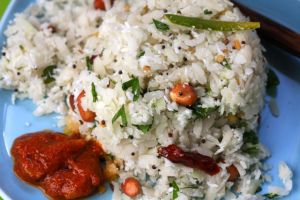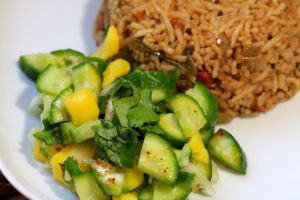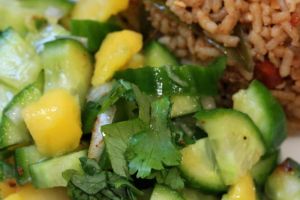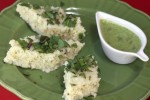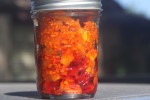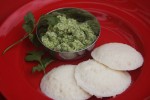Have you ever been searching for something in your pantry or kitchen only to find a whole package of something else? And then realize that you really should use it soon before it expires/stales/etc.? That’s what happened today when I found a very large bag of thick poha. It was a pleasant surprise since my hubby and I both love poha. In case you don’ t know about this unusual ingredient, poha is also called “beaten rice” and “flattened rice”. It’s basically a dried flattened raw rice product that can be used raw or cooked. Poha is used in Indian snacks, breakfasts, lunches and light meals in both savory and sweet preparations. It can be added to some dosa batters to thicken the batter. It’s an ingredient that is easy to work with and keeps a long time. Pick up a package next time you are in an Asian or Indian market! A few years ago I posted a recipe for the thin variety of poha.
Here’s a simple recipe I made for lunch today that turned much better than I expected. I started looking in a few cookbooks for ideas, but didn’t really find anything that seemed new. My usual go-to recipe for thick poha uses onion and potato. That seemed too heavy for today. Therefore, I started out with a very basic recipe but tweaked it a bit by adding peanuts (for protein), cilantro for more flavor and lots of coconut. It turned out light, spicy and very tasty. I hope you try it too!
Coconut & Peanut Poha (Serves 4)
4 cups of thick poha
4 tbsp coconut oil
1/2 cup raw peanuts (or roasted peanuts)
2 tsp salt or to taste
1 1/2 tsp mustard seeds
2 tsp urad dal
1/2 tsp cumin seeds
2 dried red chili peppers, broken
1 green chili peppers, sliced
4 tbsp water
sprig of curry leaves
1/2 cup fresh or frozen (not sweet!) coconut flakes
cilantro – about 1/2 cup chopped
lemon slices
The poha is a little tricky. It’s easy to make it too soft so be careful. You don’t want it too soft and soggy nor do you want it “al dente”: Place the poha in a large colander or strainer and place in the sink. Quickly wash the poha with water running, using your hand to fluff it and get each grain wet. Let the water drain immediately. Let sit for a few minutes. It should have softened without any additional water. Taste a bite to see if it’s soft enough for you. When it’s ready, place it in a large bowl and set aside.
Heat a medium-sized pan of your choice over medium heat. Add the coconut oil and raw peanuts (if using roasted peanuts, skip this step). Allow the peanuts to fry a bit until they are browned. Once done, immediately remove from the oil to a plate (leaving the oil in the pan), sprinkle with a bit of salt and allow to cool.
Now add the mustard seeds to the oil. Once popping, add the urad dal, cumin seeds, red chili peppers, green chili peppers and curry leaves. Carefully add the water and allow it to cook off. This will make the urad dal soft. When the water is evaporated, pour this seasoning over the washed poha.
Now toss in the peanuts, coconut flakes and cilantro. Add salt to taste. Stir gently but well. If the poha is a bit too wet it may stick together. If that happens, just stir as gently as possible, breaking up pieces as you do so. Can you tell that I have experience at making the poha too soft? It’s okay if it happens, it will still taste good! Serve with some yummy garlic pickle and lemon slices to squeeze over.
